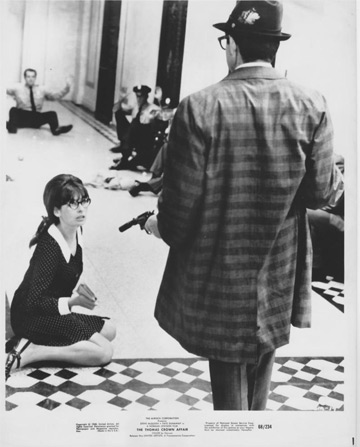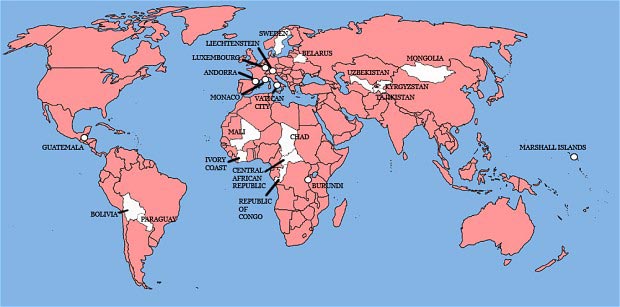within the world

What exactly about a small salad with four or five miniature croutons makes Guy’s Famous Big Bite Caesar (a) big (b) famous or (c) Guy’s, in any meaningful sense?
[…]
Hey, did you try that blue drink, the one that glows like nuclear waste? The watermelon margarita? Any idea why it tastes like some combination of radiator fluid and formaldehyde? […]
Why did the toasted marshmallow taste like fish?
[…]
ATMOSPHERE 500 seats, three levels, three bars, one chaotic mess.
SERVICE The well-meaning staff seems to realize that this is not a real restaurant.
{ NY Times | Continue reading }
food, drinks, restaurants, guide, new york | November 14th, 2012 1:15 pm

In July, Wells Fargo paid a $175 million settlement after the feds caught its brokers systematically pushing minority customers into mortgages with higher rates and fees, even though they posed the same credit risks as whites.
One study found that Wells Fargo charged Hispanics $2,000 more in what the Justice Department called a “racial surtax.” The bank docked blacks nearly $3,000 extra for their own improper pigmentation.
Across the country, in Minneapolis, U.S. Bank also swindled its customers, though at least it let whites in on the action. Instead of logging debit card purchases in the order they were made, the bank rearranged them from highest amount to lowest, the better to artificially stick customers with overdraft fees.
U.S. Bank paid $55 million to settle a class action suit in July. It was the 13th major bank caught running this scam.
These were just the opening salvos of the assault. Bank of America was caught illegally foreclosing on the homes of active-duty soldiers. Visa and MasterCard were charged with fixing the prices they charged merchants to process credit card payments. Morgan Stanley colluded to drive up New York electricity prices. And in the most depraved case of all, Morgan Stanley was even sued for allegedly swindling Irish nuns in an investment deal.
{ Village Voice | Continue reading }
U.S., economics, scams and heists | November 13th, 2012 4:09 pm

Foxconn, the maker of Apple’s iPhone and iPad, plans to rely more on robots for manufacturing over the coming years, allowing the company to invest more in research and development and save on labor costs. […]
Local Chinese media reported that Foxconn CEO Terry Gou had said the company plans on deploying 1 million robots over the next three years to complete routine assembly tasks. Foxconn currently uses 10,000 robots. […]
The Taiwan-based company has more than 1 million employees, the majority of which are located at facilities in mainland China. Foxconn is one of the world’s largest producers of electronics. Aside from Apple, the company also manufactures products for companies like HP, Sony and Nintendo.
{ IT World | Continue reading }
asia, economics, future, robots & ai | November 13th, 2012 11:51 am
flashback, within the world | November 7th, 2012 9:12 am

For nearly a decade, scientists have told city and state officials that New York faces certain peril: rising sea levels, more frequent flooding and extreme weather patterns. The alarm bells grew louder after Tropical Storm Irene last year, when the city shut down its subway system and water rushed into the Rockaways and Lower Manhattan.
On Tuesday, as New Yorkers woke up to submerged neighborhoods and water-soaked electrical equipment, officials took their first tentative steps toward considering major infrastructure changes that could protect the city’s fragile shores and eight million residents from repeated disastrous damage. […]
“The construction of this city did not anticipate these kinds of situations. We are only a few feet above sea level,” Mr. Cuomo said during a radio interview. “As soon as you breach the sides of Manhattan, you now have a whole infrastructure under the city that fills — the subway system, the foundations for buildings,” and the World Trade Center site. […]
After rising roughly an inch per decade in the last century, coastal waters in New York are expected to climb as fast as six inches per decade, or two feet by midcentury, according to a city-appointed scientific panel. That much more water means the city’s flood risk zones could expand in size. […]
What scientists, who have devoted years of research to the subject, now fear most is that, as soon as the cleanup from this storm is over, the public will move on.
{ NY Times | Continue reading }
related { What Will Happen to the NYC Subway Rats? }
economics, elements, incidents, new york | October 31st, 2012 7:56 am

Singapore plans to restrict advertising for “unhealthy” food and drink aimed at children, as countries across Asia grow increasingly concerned about obesity rates. […]
About 11 per cent of adults in the island nation of 5.3m are considered obese, compared with an OECD average of 17 per cent and a US figure of more than 35 per cent. […]
About 60 per cent of Singaporeans eat out four times a week or more, mostly in “hawker stalls” and food courts scattered across the city state that sell cheap dishes based on rice and noodles that are often heavy on cooking oil. Fast food outlets such as McDonald’s and KFC are also popular. […]
The government has been working with food stall owners to cut the amount of oil and salt used in cooking and persuade them to use brown rice, considered healthier than polished white rice.
It has also introduced a system of early morning “mall walks” designed to encourage shoppers in Singapore’s numerous malls to exercise before stores open.
{ FT | Continue reading }
asia, food, drinks, restaurants, health, law | October 29th, 2012 1:59 pm

Every several years, IQ tests test have to be “re-normed” so that the average remains 100. This means that a person who scored 100 a century ago would score 70 today; a person who tested as average a century ago would today be declared mentally retarded. […]
Do rising IQ scores really mean we are getting smarter? […]
Implicit in Flynn’s argument that we are becoming “more modern” is that IQ gains are due to environmental factors, not genetic ones. […] He invokes environmental factors, for example, to explain the shrinking male/female IQ gap and debunk notions of innate differences in intelligence between men and women. He uses similar reasoning to explain IQ differences between developed and developing countries.
{ TNR | Continue reading }
photo { Johan Willner }
ideas, science, within the world | October 26th, 2012 9:18 am

In 1964–to the disgust and dismay of most of my academic friends–I served as an economic adviser to Barry Goldwater during his quest for the Presidency. That year also, I was a Visiting Professor at Columbia University. The two together gave me a rare entree into the New York intellectual community. I talked to and argued with groups from academia, from the media, from the financial community, from the foundation world, from you name it. I was appalled at what I found. There was an unbelievable degree of intellectual homogeneity, of acceptance of a standard set of views complete with cliche answers to every objection, of smug self-satisfaction at belonging to an in-group. The closest similar experience I have ever had was at Cambridge, England, and even that was a distant second.
The homogeneity and provincialism of the New York intellectual community made them pushovers in discussions about Goldwater’s views. They had cliche answers but only to their self-created straw-men. To exaggerate only slightly, they had never talked to anyone who really believed, and had thought deeply about, views drastically different from their own. As a result, when they heard real arguments instead of caricatures, they had no answers, only amazement that such views could be expressed by someone who had the external characteristics of being a member of the intellectual community, and that such views could be defended with apparent cogency. Never have I been more impressed with the advice I once received: “You cannot be sure that you are right unless you understand the arguments against your views better than your opponents do.
{ Milton Friedman | via EconLog }
ideas, new york | October 12th, 2012 12:28 pm

One of the many consequences of global warming is that it’s now, for the first time, possible to drill under the sea bed of the Arctic ocean. The oil companies are all there, of course, running geological tests and bickering with each other about the potential environmental consequences of an oil spill. But they’re not the only people drilling. Because there’s something even more valuable than oil just waiting to be found under the Arctic.
What is worth so much money that three different consortiums would spend billions of pounds to retrofit icebreakers and send them into some of the coldest and most dangerous waters in the world? The answer, of course, is information.
A couple of days ago, I called a friend in Tokyo, and we had a lovely chat. If he puts something up on Twitter, I can see it immediately. And on the web there are thousands of webcams showing me what’s going on in Japan this very second. It doesn’t look like there’s any great information bottleneck there: anything important which happens in Japan can be, and is, transmitted to the rest of the world in a fraction of a second.
But if you’re a City trader, a fraction of a second is a veritable eternity. Let’s say you want to know the price of a stock on the Tokyo Stock exchange, or the exact number of yen being traded for one dollar. Just like the light from the sun is eight minutes old by the time it reaches us, all that financial information is about 188 milliseconds old by the time it reaches London. That’s zero point one eight eight seconds. And it takes that much time because it has to travel on fiber-optic cables which take a long and circuitous route: they either have to cross the Atlantic, and then the US, and then the Pacific, or else they have to go across Europe, through the Middle East, across the Indian Ocean, and then up through the South China Sea between China and the Philippines.
But! If you can lay an undersea cable across the Arctic, you can save yourself about 5,000 miles, not to mention the risk of routing your information past a lot of political flash points. And when you’re sitting in your office in London and you get that dollar/yen exchange rate from Tokyo, it’s fresh from the oven, comparatively speaking: only 0.168 seconds old. If everybody else is using the old cables and you’re using the new ones, then you have somewhere between 20 milliseconds and 60 milliseconds when you know something they don’t.
Those are periods of time so short that humans can barely notice them. This essay, for instance, is about 900,000 milliseconds long, and it takes me hundreds milliseconds just to say the word “cable”. Which is a word with more than one meaning. To you, it probably means some kind of wire. But to City traders, it means 1.6254, or something very close to that number. Because in the City, “cable” means the pound/dollar exchange rate. And it’s named that after a transatlantic cable which was used to telegraph the exchange-rate information from London to New York as far back as 1858. […]
Obviously, only computer algorithms can make money from an information advantage which is measured in milliseconds. It’s computers which are making the decisions to buy and sell: if they had to wait for a human to sign off on those things, they’d never make any money at all. […] The more obvious problem with exchanges run by computers is that computers don’t have any common sense.
{ Felix Salmon/Reuters | Continue reading }
photo { Edward Weston }
economics, ideas, technology, traders, within the world | October 9th, 2012 4:14 am
How can you live in a city like Karachi with all its rampant violence? I can’t really confess to the folks in my village that, unlike in the rest of Pakistan, in Karachi you can buy beer without much hassle. (Alcohol is illegal throughout the country.)
Nobody knows how many people live in Karachi. Current estimates range between 17 and 20 million. I have never met anyone who has seen the whole of the city. Every few months, you’ll hear of a neighborhood that you’ve never heard of before. […]
Half a dozen people are killed on an average day: for political reasons, for resisting an armed robbery, for not paying protection money, and sometimes for just being in the wrong spot when two groups are having a go at each other.
{ The New Republic | Continue reading }
asia, experience | October 2nd, 2012 5:57 am
Mr. Romney’s practice debates have gone worse than expected, with the former Massachusetts governor getting trounced by a variety of opponents, including the Apple personal assistant Siri.
{ Andy Borowitz/The New Yorker | Continue reading }
U.S., haha | October 1st, 2012 2:25 pm

Google Chairman Eric Schmidt says Apple should have continued to use Google’s mapping application in iOS 6 instead of swapping it out for its poorly received home-brewed replacement, and given the sour reception Apple’s Maps app has been given, he may have been right.
But multiple sources familiar with Apple’s thinking say the company felt it had no choice but to replace Google Maps with its own, because of a disagreement over a key feature: Voice-guided turn-by-turn driving directions.
{ All Things D | Continue reading }
related { Ecce Homo }
economics, google, within the world | September 27th, 2012 12:36 pm
economics, technology, within the world | September 24th, 2012 11:12 am

Researchers have long documented that the most educated Americans were making the biggest gains in life expectancy, but now they say mortality data show that life spans for some of the least educated Americans are actually contracting. Four studies in recent years identified modest declines, but a new one that looks separately at Americans lacking a high school diploma found disturbingly sharp drops in life expectancy for whites in this group. Experts not involved in the new research said its findings were persuasive.
The reasons for the decline remain unclear, but researchers offered possible explanations, including a spike in prescription drug overdoses among young whites, higher rates of smoking among less educated white women, rising obesity, and a steady increase in the number of the least educated Americans who lack health insurance.
The steepest declines were for white women without a high school diploma, who lost five years of life between 1990 and 2008. […] The dropping life expectancies have helped weigh down the United States in international life expectancy rankings, particularly for women. […] Among developed countries, American women sank from the middle of the pack in 1970 to last place in 2010.
{ NY Times | Continue reading }
U.S., health | September 21st, 2012 11:39 am
U.S., haha | September 18th, 2012 3:20 pm

{ From David Graham, here is the graph of the 47% — a.k.a. “non-payers” — by state. The ten states with the highest share of “non-payers” are in the states colored red. Most are in southern (and Republican) states. Meanwhile, the 13 states with the smallest share of “non-payers” are in blue. Most are northeastern (and Democratic) states. | Atlantic | full story }
U.S. | September 18th, 2012 3:00 pm
new york | September 17th, 2012 3:12 pm

At 12 or 13, we started taking buses to New York City and going to raves. My friends and I discovered this underground culture and adopted this great style that was still foreign to our small upstate community. At the height of the rave scene, I could have described myself as a “polo” raver. I’d wear 60-inch wide jeans called Aura’s E, which was a brand by this girl in Long Island named Aura. I shaved my eyebrows completely off, pierced everything on my face, put platforms on my running sneakers… I’d work day and night in the mall upstate so that I could buy my rave tickets and take bus trips to get all the cool clothes in the city. I found out about everything from shops like Liquid Sky and Satellite Records––they would put flyers out and you had to call hotlines to find out all the rave info. All the great mixtapes were sold at the stores too. It was a real beautiful time to be a teenager and so close to NYC.
{ David Benjamin Sherry | Continue reading }
experience, new york, photogs | August 30th, 2012 1:28 pm

The first goal was to halve the proportion of the world’s population living on a dollar a day by 2015. […]
The target had actually been met in 2008, seven years ahead of schedule. This staggering achievement received no fanfare, perhaps because the miracle had not been created by Western governments but by the economic progress of China and India.
{ Telegraph | Continue reading }
photo { Christophe Agou }
economics, within the world | August 30th, 2012 5:20 am

On a Sunday night in May 1935, Victor Lustig was strolling down Broadway on New York’s Upper West Side. At first, the Secret Service agents couldn’t be sure it was him. They’d been shadowing him for seven months, painstakingly trying to learn more about this mysterious and dapper man, but his newly grown mustache had thrown them off momentarily. As he turned up the velvet collar on his Chesterfield coat and quickened his pace, the agents swooped in. […]
Secret Service agents finally had one of the world’s greatest imposters, wanted throughout Europe as well as in the United States. He’d amassed a fortune in schemes that were so grand and outlandish, few thought any of his victims could ever be so gullible. He’d sold the Eiffel Tower to a French scrap-metal dealer. He’d sold a “money box” to countless greedy victims who believed that Lustig’s contraption was capable of printing perfectly replicated $100 bills. (Police noted that some “smart” New York gamblers had paid $46,000 for one.) He had even duped some of the wealthiest and most dangerous mobsters—men like Al Capone, who never knew he’d been swindled.
Now the authorities were eager to question him about all of these activities, plus his possible role in several recent murders in New York and the shooting of Jack “Legs” Diamond, who was staying in a hotel room down the hall from Lustig’s on the night he was attacked.
{ Smithsonian mag | Continue reading }
photo { André Kertész, Eiffel Tower (view down), 1929 }
flashback, paris, scams and heists | August 24th, 2012 3:44 pm




















